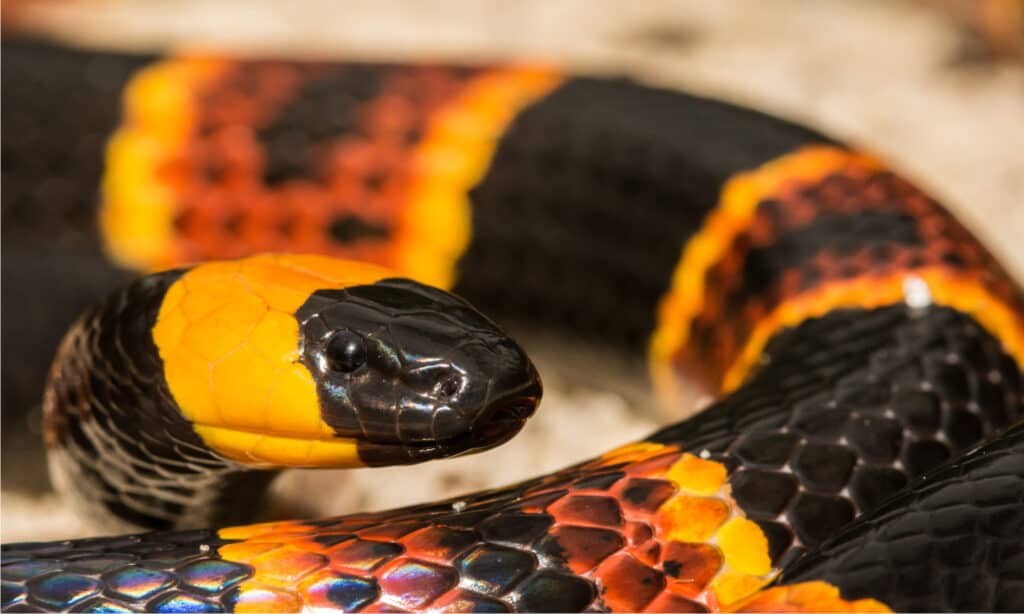Coral snakes are among the most dangerous snakes in the United States, although they are rarely seen. These elusive snakes live some of the most mysterious lives, despite being present across much of the United States. Today, we will take a look at coral snakes and learn exactly what kinds of foods they eat, plus a bit about how they hunt. Despite their reclusive behaviors, they are still studied and tracked around the country. Let’s discover what coral snakes eat!
What do coral snakes eat?

Coral snakes eat a diet of lizards, frogs, birds, rodents, and smaller snakes.
©Mark_Kostich/Shutterstock.com
Coral snakes eat lizards, frogs, birds, rodents, and smaller snakes.
The coral snake is a member of the Elapid family, meaning the cobra is its cousin! Despite this scary name, this snake mostly spends its time hiding from humans and minding its business. Part of that business, however, is eating!
There are three species of coral snakes in the United States, but they all have similar diets. Even the Texas coral snake, a species to Texas, Louisiana, Arkansas, and northern Mexico, eats similar foods to the other species.
In the Americas alone, there are 65 species of coral snake, all with their colorations, habits, and habitats. In the Old World (Europe and Asia), there are 16 species of coral snake. The original species (basal) is from Asia, but it has since spread to the rest of the world. Still, whether in the jungles of South America or the deserts of the American southwest, coral snakes generally eat the same types of food.
The types of food that coral snakes eat

Most coral snakes prefer small skinks and lizards as prey but will eat pretty much anything.
©Jay Ondreicka/Shutterstock.com
Coral snakes generally keep to a few categories of food, despite the various habitats that they can live in. The most common types of foods that coral snakes eat are lizards, frogs, and smaller snakes since those are the animals they are most likely to encounter. The vast majority of coral snakes are fossorial, meaning they spend their time under dense brush and in the undergrowth. A smaller portion of coral snakes are aquatic but still hunt frogs and lizards quite frequently.
Although less common, coral snakes will eat small rodents and nesting birds that they happen to encounter. Essentially, these snakes aren’t particularly picky when it comes to their diet and eat things that are smaller than them and happen to wander too close.
Like many other snakes, coral snakes are cannibalistic and don’t mind eating one of their own. Additionally, coral snakes will eat venomous and nonvenomous snakes alike, provided they can kill them without being killed themselves.
A complete list of foods coral snakes eat:
Here is a complete list of foods a coral snake will eat:
- small lizards
- small snakes
- skinks
- frogs
- small mice
- nesting birds
- other coral snakes
- insects
A coral snake can go for weeks or months without eating if it needs to!
How do coral snakes hunt?

Coral snakes have fixed fangs and need to “chew” their prey to inject their venom.
©Patrick K. Campbell/Shutterstock.com
Part of what makes coral snakes unique is their hunting methods. The first step for a hungry coral snake is finding food! Unlike pit vipers like the copperhead or rattlesnake, coral snakes don’t have the ability to heat-sense their way to prey. Thankfully, the prey that coral snakes prefer often lives nearby. Using their tongues to smell, coral snakes can track desired prey and get relatively close.
Once they are close enough to strike, the next step is to bite. Coral snakes are extremely venomous, although they aren’t great at delivering that venom to their prey. The main reason coral snakes can’t deliver a lot of venom is the design of their mouth; it’s extremely small! The size of their mouth not only limits how hard they can bite but the types of prey they can eat. Also, coral snakes have fixed fangs, unlike the retractable fangs vipers have.
Instead of biting and releasing, coral snakes bite their prey instead and hold on. This behavior is common in snakes that eat snakes, and probably has more to do with not allowing escape than anything else. However, this behavior also likely gave rise to the myth that coral snakes have to ”chew” to envenomate.
Once the venom is in full effect, it’s extremely powerful and acts as a neurotoxic agent.
What animals hunt the coral snake?

Coral snakes are cannibalistic and don’t mind eating one another.
©iStock.com/JasonOndreicka
Although coral snakes are dangerous prey due to their venom, some animals consider them prey! The most common predators of coral snakes are the usual predators of any snake. These predators include birds of prey (owls, hawks, and falcons), coyotes, cats (domestic and wild), and other snakes.
The most likely predator of a coral snake, however, is usually another coral snake. Since these reptiles are cannibalistic, they don’t mind eating their relatives!
Next Up
- Discover the snake that farts so hard it goes flying!
- Discover the largest shovelnose snake
- Are milk snakes dangerous?
The photo featured at the top of this post is © Jay Ondreicka/Shutterstock.com
Discover the "Monster" Snake 5X Bigger than an Anaconda
Every day A-Z Animals sends out some of the most incredible facts in the world from our free newsletter. Want to discover the 10 most beautiful snakes in the world, a "snake island" where you're never more than 3 feet from danger, or a "monster" snake 5X larger than an anaconda? Then sign up right now and you'll start receiving our daily newsletter absolutely free.
Thank you for reading! Have some feedback for us? Contact the AZ Animals editorial team.






